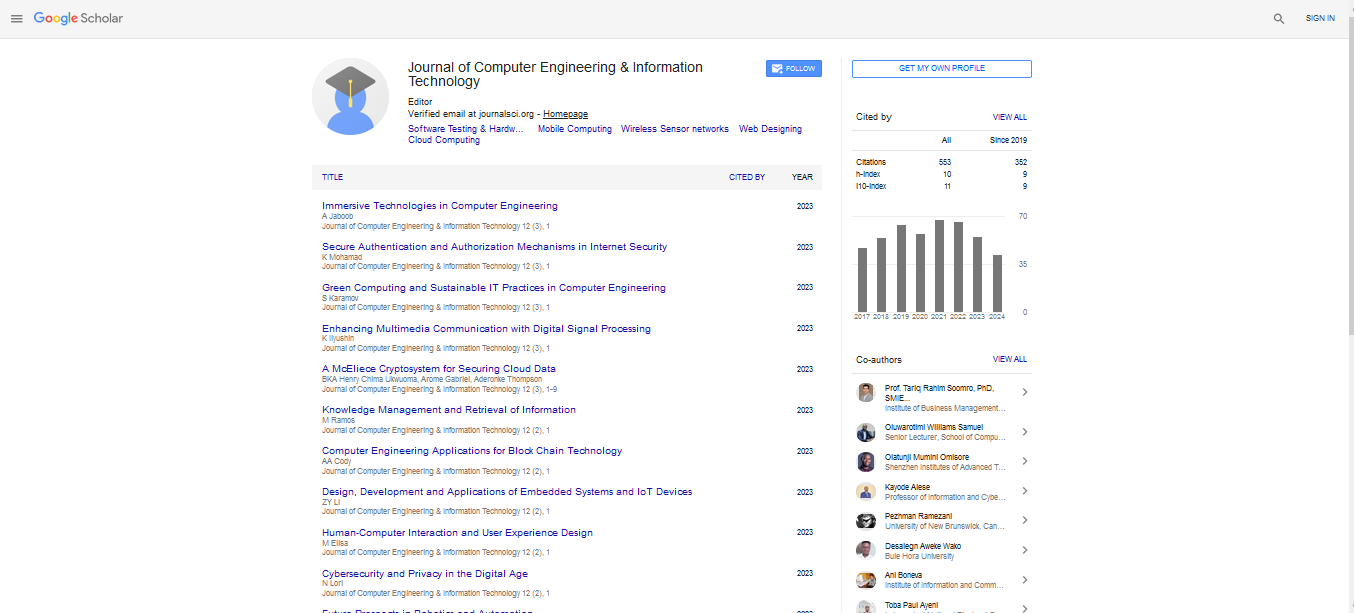Editorial, Jceit Vol: 14 Issue: 1
Database Management: Organizing Data for Efficient Access and Analysis
Sooheb Han*
Department of Geoinformatics Engineering, Kyungil University, Gyeongsansi, Korea
- *Corresponding Author:
- Sooheb Han
Department of Geoinformatics Engineering, Kyungil University, Gyeongsansi, Korea
E-mail: han@soo.kr
Received: 01-Jan-2025, Manuscript No. jceit-25-169307; Editor assigned: 4-Jan-2025, Pre-QC No. jceit-25-169307 (PQ); Reviewed: 20-Jan-2025, QC No jceit-25-169307; Revised: 27-Jan-2025, Manuscript No. jceit-25-169307 (R); Published: 31-Jan-2025, DOI: 10.4172/2324-9307.1000330
Citation: Sooheb H (2025) Database Management: Organizing Data for Efficient Access and Analysis. J Comput Eng Inf Technol 14: 330
Introduction
In the digital age, data is a critical asset for individuals, businesses, and governments alike. Efficiently storing, managing, and retrieving vast amounts of data requires sophisticated systems known as Database Management Systems (DBMS). Database management involves the use of software tools and techniques to store, organize, secure, and manipulate data effectively [1], ensuring that information is accessible, consistent, and reliable. This field is fundamental to modern computing, supporting applications from banking and healthcare to e-commerce and social media.
What is Database Management?
Database management refers to the processes and technologies involved in creating, maintaining, and using databases. A Database Management System (DBMS) is software that interacts with end-users, applications, and the database itself to capture and analyze data. It ensures data integrity, security, and availability, facilitating efficient data operations.
Key functions of database management include:
Data Storage: Organizing data in structured formats like tables.
Data Retrieval: Allowing users to query the database to extract meaningful information.
Data Manipulation: Inserting, updating, and deleting data records.
Data Security: Controlling access to protect sensitive information [2].
Backup and Recovery: Protecting data from loss or corruption.
Types of Database Models
Several database models have evolved to suit different needs:
Relational Databases: Store data in tables with relationships; use SQL for queries (e.g., MySQL, Oracle).
NoSQL Databases: Handle unstructured or semi-structured data; designed for scalability (e.g., MongoDB, Cassandra).
Hierarchical Databases: Data organized in tree-like structures.
Network Databases: Complex many-to-many relationships using graph structures.
Object-Oriented Databases: Store data as objects, integrating with object-oriented programming.
Components of a DBMS
A typical DBMS consists of:
Database Engine: Handles data storage, retrieval, and management.
Query Processor: Interprets and executes database queries [3].
Database Schema: Defines the logical structure of the database.
Transaction Management: Ensures database consistency and handles concurrent access.
Metadata: Data about data, describing database structure.
Applications of Database Management
Database management systems are ubiquitous across industries:
Banking: Managing customer accounts, transactions, and fraud detection.
Healthcare: Storing patient records, diagnostic data, and treatment history.
E-Commerce: Tracking inventory, sales, and customer data.
Telecommunications: Managing call records and billing information.
Education: Student records, course management, and research databases.
Challenges and Future Trends
Managing databases involves addressing challenges like data security, scalability, and performance optimization [4]. The growing volume and variety of data due to Big Data and IoT require innovative approaches to database management.
Emerging trends include:
Cloud Databases: Offering scalable, on-demand access with reduced maintenance [5].
Distributed Databases: Spreading data across multiple locations for reliability.
AI and Machine Learning Integration: Enhancing query optimization and anomaly detection.
Blockchain Databases: Providing immutable and transparent data records.
Conclusion
Database management is essential for harnessing the power of data in today’s information-driven world. Effective database systems enable organizations to store vast amounts of data securely, retrieve information quickly, and maintain data integrity. As data continues to grow exponentially, evolving database management technologies will be crucial for future innovation and decision-making.
References
- Merkel D (2014) Docker: Lightweight Linux containers for consistent development and deployment. Linux Journal 2014.
- Red Hat (2023) Docker vs. Podman: Whatâ??s the difference?
- Kubernetes Documentation. (2021). Dockershim Deprecation FAQ.
- IBM. (2023). A complete guide to containerization.
- Docker, Inc. (2024). What is a container?
Indexed at, Google Scholar, Crossref
Indexed at, Google Scholar, Crossref
Indexed at, Google Scholar, Crossref
Indexed at, Google Scholar, Crossref
 Spanish
Spanish  Chinese
Chinese  Russian
Russian  German
German  French
French  Japanese
Japanese  Portuguese
Portuguese  Hindi
Hindi 